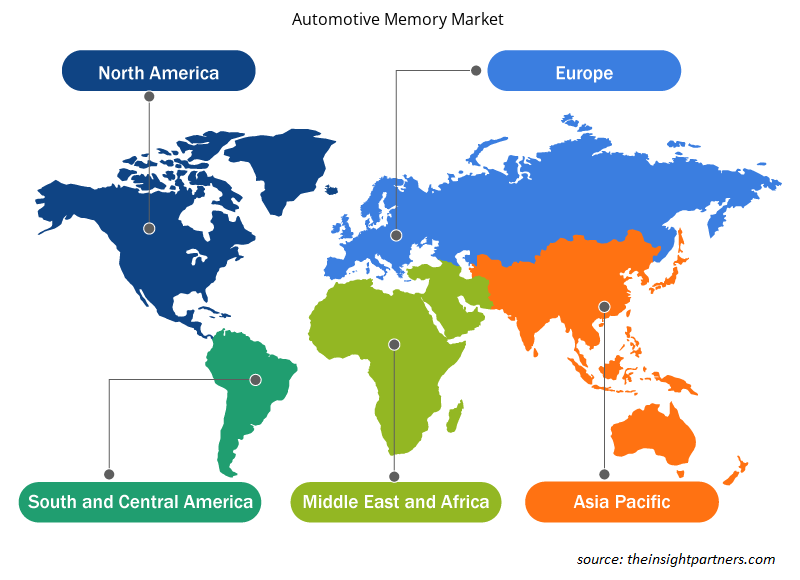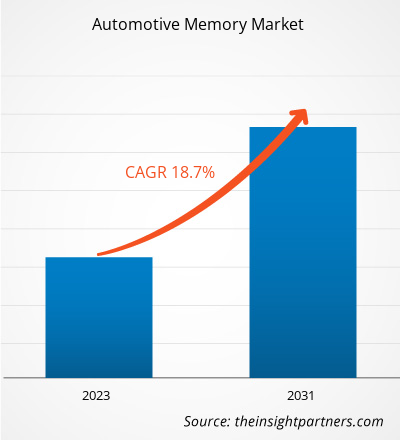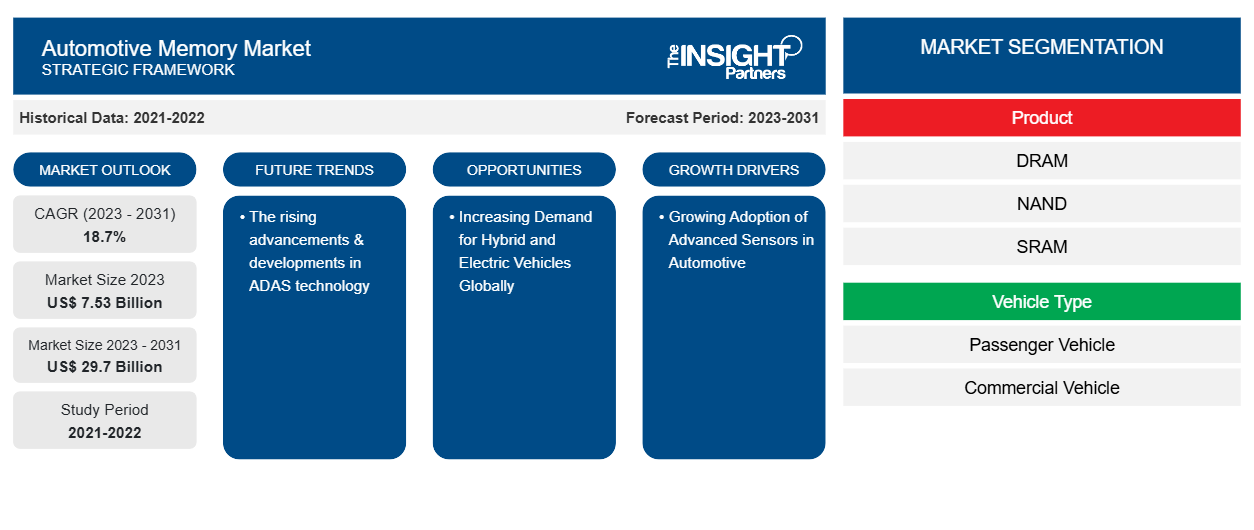Le marché des mémoires automobiles devrait atteindre 29,7 milliards de dollars d'ici 2031, contre 7,53 milliards de dollars en 2023. Le marché devrait enregistrer un TCAC de 18,7 % au cours de la période 2023-2031. Les progrès et développements croissants de la technologie ADAS devraient rester des tendances clés du marché.
Analyse du marché de la mémoire automobile
L'augmentation de la demande en télématique automobile et l'adoption de capteurs dans les applications automobiles devraient stimuler la demande de mémoire automobile, ce qui devrait à son tour alimenter la croissance du marché dans les années à venir. En outre, les normes gouvernementales strictes concernant le déploiement de la télématique dans les véhicules devraient stimuler la croissance du marché de 2023 à 2031. De plus, la demande croissante de véhicules électriques hybrides et de véhicules électriques à travers le monde devrait alimenter la demande de mémoires automobiles, ce qui devrait à son tour créer des opportunités pour les principales entreprises du marché au cours de la période de prévision.
Aperçu du marché de la mémoire automobile
Les véhicules sont actuellement équipés de divers types de mémoire distribuée, tels que la mémoire vive statique, la mémoire vive dynamique, la mémoire morte , la mémoire FLASH et, dans certains cas, la mémoire vive magnétorésistive (MRAM). Test. Le stockage automobile est similaire en termes de fonctionnement au stockage commercial, mais fonctionne différemment. Il est plus proche des mémoires ECC (Error Correcting Code), qui s'appuient sur le résultat de l'accès à la mémoire et sur l'exactitude des informations stockées. À mesure que de plus en plus de microprocesseurs sont utilisés, la DRAM distribuée est utilisée, qui est responsable localement du signal, du traitement des informations et du stockage SRAM ou FLASH pour transférer les informations entre les fonctions du véhicule.
La nouvelle architecture automobile comprend une unité centrale de traitement primaire (CPU) centralisée dotée d'une énorme mémoire comparable à celle d'un ordinateur normal. Sur la base des données de tous les sous-systèmes d'assistance au conducteur, du moteur et de la transmission, cette unité traite et prend des décisions systémiques. Contrairement aux ordinateurs domestiques et professionnels, qui ont une durée de vie de 2 à 5 ans, le stockage automobile doit fonctionner en continu pendant 12 à 20 ans.
Personnalisez ce rapport en fonction de vos besoins
Vous bénéficierez d'une personnalisation gratuite de n'importe quel rapport, y compris de certaines parties de ce rapport, d'une analyse au niveau des pays, d'un pack de données Excel, ainsi que d'offres et de remises exceptionnelles pour les start-ups et les universités.
-
Obtenez les principales tendances clés du marché de ce rapport.Cet échantillon GRATUIT comprendra une analyse de données, allant des tendances du marché aux estimations et prévisions.
Facteurs moteurs et opportunités du marché de la mémoire automobile
L'adoption croissante de capteurs avancés dans l'automobile favorise le marché
Les capteurs automobiles sont essentiels au bon fonctionnement des automobiles modernes. Ces capteurs fournissent des informations sur de nombreux paramètres du véhicule à l'unité de commande électronique (ECU), maximisant ainsi la sécurité, l'efficacité et les performances. Ils le font en convertissant des quantités physiques en impulsions électriques. Ces capteurs sont classés en deux catégories principales : premièrement, par les propriétés physiques qu'ils mesurent, et deuxièmement, par la technologie sous-jacente qu'ils utilisent. Les capteurs aident à réduire les erreurs causées par l'usure ou la contamination, à assurer des mesures stables et à économiser de l'espace dans les environnements à haute température. La demande de capteurs de pression devrait augmenter et faire progresser rapidement l'industrie. Les capteurs de pression sont installés dans les portes latérales de la voiture qui envoient des signaux de collision numériques à l'unité centrale d'airbag pour éviter les accidents. Par conséquent, l'augmentation de l'adoption de capteurs avancés dans les applications automobiles devrait stimuler la croissance du marché dans les années à venir.
Demande croissante de véhicules hybrides et électriques à l'échelle mondiale
L'augmentation du nombre de véhicules entièrement électriques (VE) et de véhicules électriques hybrides, accompagnée de l'émergence des ADAS, du combiné d'instruments graphique (GIC), des systèmes d'infodivertissement et des solutions de conduite entièrement autonome, a créé une demande d'unités de contrôle électronique (ECU) - des contrôleurs automobiles utilisés pour recevoir et traiter les signaux des capteurs et exporter les commandes de contrôle vers l'actionneur pour exécution. Par exemple, aux États-Unis, les nouvelles voitures électriques immatriculées en 2023 ont totalisé environ 1 400 000 unités, soit une augmentation de 40 % par rapport à 2022. Une telle augmentation de la demande de véhicules électriques devrait créer une opportunité pour les principaux acteurs opérant sur le marché de la mémoire automobile.
Analyse de segmentation du rapport sur le marché de la mémoire automobile
Les segments clés qui ont contribué à l’élaboration de l’analyse du marché de la mémoire automobile sont le produit, le type de véhicule et l’application.
- En fonction du produit, le marché de la mémoire automobile est divisé en DRAM, NAND, SRAM, NOR et autres. Le segment DRAM détenait la plus grande part de marché en 2023.
- Par type de véhicule, le marché est segmenté en véhicule de tourisme et véhicule utilitaire. Le segment des véhicules de tourisme détenait la plus grande part du marché en 2023.
- Par application, le marché est classé en infodivertissement et connectivité, ADAS et autres. Les autres segments détenaient une part importante du marché en 2023.
Analyse des parts de marché des mémoires automobiles par zone géographique
La portée géographique du rapport sur le marché de la mémoire automobile est principalement divisée en cinq régions : Amérique du Nord, Asie-Pacifique, Europe, Moyen-Orient et Afrique, et Amérique du Sud et centrale.
Français Le rapport sur le marché de la mémoire automobile couvre l'Amérique du Nord (États-Unis, Canada et Mexique), l'Europe (Espagne, Royaume-Uni, Allemagne, France, Italie et reste de l'Europe), l'Asie-Pacifique (Corée du Sud, Chine, Inde, Japon, Australie et reste de l'Asie-Pacifique), le Moyen-Orient et l'Afrique (Afrique du Sud, Arabie saoudite, Émirats arabes unis et reste du Moyen-Orient et de l'Afrique) et l'Amérique du Sud (Brésil, Argentine et reste de l'Amérique du Sud). En termes de chiffre d'affaires, l'Asie-Pacifique a dominé la part de marché de la mémoire automobile en 2023. L'Amérique du Nord est le deuxième contributeur au marché mondial de la mémoire automobile, suivie de l'Europe.
Aperçu régional du marché de la mémoire automobile
Les tendances régionales et les facteurs influençant le marché de la mémoire automobile tout au long de la période de prévision ont été expliqués en détail par les analystes d’Insight Partners. Cette section traite également des segments et de la géographie du marché de la mémoire automobile en Amérique du Nord, en Europe, en Asie-Pacifique, au Moyen-Orient et en Afrique, ainsi qu’en Amérique du Sud et en Amérique centrale.

- Obtenez les données régionales spécifiques au marché de la mémoire automobile
Portée du rapport sur le marché de la mémoire automobile
| Attribut de rapport | Détails |
|---|---|
| Taille du marché en 2023 | 7,53 milliards de dollars américains |
| Taille du marché d'ici 2031 | 29,7 milliards de dollars américains |
| Taux de croissance annuel composé mondial (2023-2031) | 18,7% |
| Données historiques | 2021-2022 |
| Période de prévision | 2023-2031 |
| Segments couverts |
Par produit
|
| Régions et pays couverts |
Amérique du Nord
|
| Leaders du marché et profils d'entreprises clés |
|
Densité des acteurs du marché de la mémoire automobile : comprendre son impact sur la dynamique commerciale
Le marché des mémoires automobiles connaît une croissance rapide, tirée par la demande croissante des utilisateurs finaux en raison de facteurs tels que l'évolution des préférences des consommateurs, les avancées technologiques et une plus grande sensibilisation aux avantages du produit. À mesure que la demande augmente, les entreprises élargissent leurs offres, innovent pour répondre aux besoins des consommateurs et capitalisent sur les tendances émergentes, ce qui alimente davantage la croissance du marché.
La densité des acteurs du marché fait référence à la répartition des entreprises ou des sociétés opérant sur un marché ou un secteur particulier. Elle indique le nombre de concurrents (acteurs du marché) présents sur un marché donné par rapport à sa taille ou à sa valeur marchande totale.
Les principales entreprises opérant sur le marché de la mémoire automobile sont :
- Micron Technologie Inc.
- Samsung Electronics Co., Ltd.
- Société Toshiba
- Technologies numériques occidentales, Inc.
- SK Hynix
- Macronix International Co.
Avis de non-responsabilité : les sociétés répertoriées ci-dessus ne sont pas classées dans un ordre particulier.

- Obtenez un aperçu des principaux acteurs du marché de la mémoire automobile
Actualités et développements récents du marché de la mémoire automobile
Le marché des mémoires automobiles est évalué en collectant des données qualitatives et quantitatives après des recherches primaires et secondaires, qui comprennent d'importantes publications d'entreprise, des données d'association et des bases de données. Quelques-uns des développements du marché des mémoires automobiles sont répertoriés ci-dessous :
- Samsung Electronics Co., Ltd. a signé un accord avec SemiDrive. Grâce à cet accord, Samsung Electronics Co., Ltd. fournira des solutions de mémoire automobile à SemiDrive. (Source : Samsung Electronics Co., Ltd., communiqué de presse, août 2023)
- Samsung Electronics Co., Ltd. a développé une nouvelle mémoire DRAM GDDR7 32 Gbps. Ce nouveau produit de mémoire automobile étendra les capacités des applications pour l'IA, le HPC et les véhicules automobiles. (Source : Club Car, communiqué de presse, mars 2023)
Rapport sur le marché de la mémoire automobile : couverture et livrables
Le rapport « Taille et prévisions du marché de la mémoire automobile (2021-2031) » fournit une analyse détaillée du marché couvrant les domaines ci-dessous :
- Taille et prévisions du marché de la mémoire automobile aux niveaux mondial, régional et national pour tous les segments de marché clés couverts par le périmètre
- Tendances du marché de la mémoire automobile ainsi que dynamique du marché telles que les facteurs déterminants, les contraintes et les opportunités clés
- Analyse PEST et SWOT détaillée
- Analyse du marché de la mémoire automobile couvrant les principales tendances du marché, le cadre mondial et régional, les principaux acteurs, les réglementations et les développements récents du marché
- Analyse du paysage industriel et de la concurrence couvrant la concentration du marché, l'analyse de la carte thermique, les principaux acteurs et les développements récents pour le marché de la mémoire automobile
- Profils d'entreprise détaillés
- Analyse historique (2 ans), année de base, prévision (7 ans) avec TCAC
- Analyse PEST et SWOT
- Taille du marché Valeur / Volume - Mondial, Régional, Pays
- Industrie et paysage concurrentiel
- Ensemble de données Excel
Rapports récents
Témoignages
Raison d'acheter
- Prise de décision éclairée
- Compréhension de la dynamique du marché
- Analyse concurrentielle
- Connaissances clients
- Prévisions de marché
- Atténuation des risques
- Planification stratégique
- Justification des investissements
- Identification des marchés émergents
- Amélioration des stratégies marketing
- Amélioration de l'efficacité opérationnelle
- Alignement sur les tendances réglementaires























 Obtenez un échantillon gratuit pour - Marché de la mémoire automobile
Obtenez un échantillon gratuit pour - Marché de la mémoire automobile